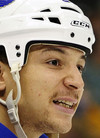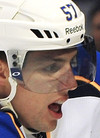Trade targets: St. Louis Blues
The Blues and Senators might again have some intersecting needs.
Some interesting news came out of St. Louis recently, as one of their prospects, center Jori Lehtera, opted to take a two-year deal to play in the KHL. He had spent the past three years there, and at the age of 25, it doesn't look like Lehetra is going to be part of the Blues' future. According to their general manager, Doug Armstrong:
"Nothing ventured, nothing gained.He didn’t want to play in the NHL. We offered him a seven-figure, one-way deal but his comfort level is in the KHL. I’m glad that if he doesn’t want to be here, he’s not here. We offered to bring him over here when his KHL season was over. He was coming off a head injury, I understood that. He didn’t think his conditioning was there, I understood that. (But) he had given me every indication that he wanted to play in the NHL. I don’t know what happened. I don’t know if we were just a bargaining chip for him to use with the KHL and he never wanted to come over. But I was under the impression from he and his agent that the NHL is where he wanted to be. Something happened where it’s not where he wanted to be."
That's interesting because, according to Armstrong, Lehtera was part of the team's future plans:
"Yeah, he was a playmaking centerman that we thought would add to our team. If we could have improved with him, we would have. We can’t, so now we’ve got to find out if there’s a way to improve with a player like that. If not, we’ve got to put the feet to the fire of the guys that are coming back."
The Blues also have four very tantalizing players hitting restricted free agency at the same time: Alex Pietrangelo, Kevin Shattenkirk, Chris Stewart and Patrik Berglund. Armstrong has already made it clear that the Blues will match any offer sheets they get for each player.
The real question, though, is whether they would be willing to move one of them for the playmaking center they're looking to add. Say, perhaps, Mika Zibanejad?
Zibanejad presents an interesting problem for the Senators, as he began to show flashes of the center he could be when an injury to Jason Spezza opened up minutes for Zibanejad on the second line--Kyle Turris moved up to take Spezza's spot.
However, when Spezza returned in the playoffs against the Pittsburgh Penguins, Turris flourished in the best spot on the team while Zibanejad struggled centering a third line alongside Z. Smith and Chris Neil. Things did not improve when Neil was swapped out for shooter Jakob Silfverberg in game 5, and Zibanejad ultimately finished with no points in five games. Ultimately, despite his size and good defensive awareness, Zibanejad is probably not suited for a checking role--he needs to be playing in the top six.
Except this isn't an option in Ottawa right now. Zibanejad is not going to oust Spezza or Turris for one of the top two center positions, and that means if he's going to play those minutes, it's going to be on the wing. This suits the Senators just fine, as Z. Smith has already demonstrated he is a fine bottom-six center, and Jean-Gabriel Pageau appears poised to make the leap to the NHL next year--he already beat out Peter Regin and Jim O`Brien to take the fourth center position after almost starting the year in the ECHL. A good offseason (combined with this year's good audition) should give him inside track on that role next season, and it's not inconceivable that he could supplant Z. Smith on the third line.
So, at the moment, it's the wing or nothing for Zibanejad, which means he could be made available to a team looking for a playmaking center. Could he be a good enough chip to get the Blues to move a player? If so, who?
| Assets: | Has a huge frame, outstanding offensive instincts and game-changing ability. Is a wizard with the puck. His wrister is top-notch. Also owns plenty of two-way upside. |
| Flaws: | Doesn't use his big frame enough to win puck battles or finish checks consistently. Could stand to shoot the puck a little more. Needs to be better from game to game. |
| Career Potential: | Slick, talented center with upside. |
via The Hockey News
In 48 games this year, Berglund had 17 goals and 8 assists. He is a big center but not terribly physical despite his size. But the Senators don't need centers, and the Blues do, so it wouldn't make sense to trade Zibanejad for Berglund.
| Assets: | Has excellent offensive capability and all-round upside. A good transition game player, his quickness, talent and poise with the puck are assets. Can make an impact on the power play. He's not big, but is stronger than he looks and will use the body effectively. |
| Flaws: | Must continue adding more bulk to his frame and overall strength in order to better handle bigger NHL forwards in front of the net. Should learn to better choose his spots when he's pinching from the point as he gains more experience. Lacks some toughness. |
| Career Potential: | Offensive defenseman with upside. |
via The Hockey News
In 48 games this year, Shattenkirk had 5 goals and 18 assists, totaling 23 points. Armstrong described him as "steady":
"He’s been an interesting three-year study because his numbers have almost stayed flat across the board. I look at that as a positive, that he’s defining himself relatively quickly."
But the Senators already have a smallish, offensive defenseman, and he's done all right. They don't have any real incentive to add what is essentially a similar player. Though Shattenkirk has good offensive skill and could conceivably fill the hole left by Sergei Gonchar's departure, there's not a major difference between him and Patrick Wiercioch at this point in their careers, and at 6'4", Wiericoch has the frame to be more than merely a puck-mover. A Zibanejad-for-Shattenkirk trade would be a very slight overpayment by the Senators, as they'd be moving a potential 1C for a second-pairing defenseman on their roster. It's a move that could work with some tinkering, but there are bigger fish out there.
| Assets: | Owns tremendous size and strength, and is at his best when working the corners of the ice. Is physical and plays with a warrior's mentality (most of the time). Is faster than most think, and has what it takes to score goals, including a bullet for a shot. |
| Flaws: | Consistency continues to escape him, which he needs in order to hit the next level of his development. Has to play with an edge at all times, since he cannot get by with talent alone. Must also continue working on his play away from the puck and in his own end. |
| Career Potential: | Inconsistent but talented power forward with a little upside. |
via The Hockey News
Chris Stewart is the player the Senators hoped Nick Foligno would be. He led his team in points this season with 18 goals and 18 assists in 48 games. Repeatedly billed as a 30-goal guy, that's a mark he has yet to hit in his career, though his point totals indicate that's not unreasonable: In 2009-10, he had 64P (28G, 36A) in 77 games with Colorado, which remains his career high. The following year he was traded to St. Louis, and between the two teams, he recorded 53P (28G, 25A) in 62 games. Last season, however, he managed only 30P (15G, 15A) in 79 games. And he recorded just one assist in six games in the playoffs this year, an unimpressive followup to his 2011-12 playoffs that saw him notch two goals (both coming in a 4-2 loss against the Los Angeles Kings) in seven games. It would appear that both the 30-goal and inconsistent labels could be deserved.
In imaginary scenarios, Stewart is the player who will be blessed by the magic hands of Jason Spezza, whose offensive skills let his wingers soar to greater heights. "If he could get close to 30 without Spezza," the story goes, "just imagine what he could do with Spezza!" Well... probably around 30 goals. Remember, Spezza already plays with a winger who flirted with 30 goals: Milan Michalek--and in their first year under Paul MacLean, Michalek recorded 35 goals and 25 assists with Spezza. Those 60 points were still less than his career high of 66, but tell us that Michalek's ceiling is probably as a mid-50 to 60-point player. Stewart's ceiling, even with Spezza, is probably as a 60-point player.
Except, of course, that Stewart wouldn't be replacing Michalek in this scenario--he'd be replacing Zibanejad. You know, the guy who's playing on the wing because that's the only place to get him top six minutes? Stewart is a RW, which would cause a slight logjam in the top six with Silfverberg and Daniel Alfredsson already playing those spots, but both Swedes have the intelligence to play LW if called upon, and Alfie's retirement is closer than it is farther.
There's no denying that at this point in their careers, Stewart is a much better option on the wing than Zibanejad could be for the Senators, so a trade here could have real traction. Except--if I'm the Blues, Stewart is exactly the kind of player I want to put on Zibanejad's wing. Sure, they still have Vladimir Tarasenko, but there's not much point in trading for a playmaking center if you don't surround him with guys who can finish his plays. Stewart would look great for the Senators in front of opponents' nets, especially with someone like Erik Karlsson taking ten shots a game, but the Blues would probably prefer to keep him.
| Assets: | Has excellent size, two-way ability and loads of offensive acumen. Is aggressive in nature and never afraid to lay on the body. Plays with poise and excels with the man advantage; he has a quality point shot. An excellent skater for such a big man, he's also a good playmaker. |
| Flaws: | Needs a little more work in terms of his defensive-zone coverage, as well as learn how to make a few safer plays when in danger in his own end of the ice. Injuries are also a bit of a concern, mostly because his playing style can leave him vulnerable at times. |
| Career Potential: | Excellent all-round defenseman with big upside. |
via The Hockey News
This is the big fish. Pietrangelo finished fourth in Norris Trophy voting last season (the guy he lost to would be his partner in Ottawa) but had a regression this year. It wasn't as precipitous a drop as, say, the illiterate Tyler Myers, but it's obvious Armstrong doesn't want to overpay a young defenseman who's still developing. In his own words:
"He had a good year, but not as good a year as his second year. So we have to figure out where all that fits into the market moving forward. As I look at our group, he has the best opportunity to be an elite (player) of anyone on our team right now. But opportunity has to cross-sect with the final result."
Makes sense. It's a mistake throwing too much money at a young player before you're sure what you've got--except the Blues would have to be blind not to know what they've got in Pietrangelo. He's a stud, a true stud, and he's not moving for cheap. Armstrong would have to believe that Zibanejad is a future top-line center to even think about moving Pietrangelo, and that would be just the starting point. The Senators would also have to throw in their first rounder, and a defenseman as well, either Patrick Wiercioch or Jared Cowen (preferably Wiercioch), and hope that two good young players who can contribute immediately and a decent pick in a deep draft would be enough to bag a great young player. The odds of this happening are low, but ask yourself: The year before Karlsson won the Norris Trophy, when he put up 45 points in 75 games and was a minus-30, would you have taken a potential 1C and potential top-4 offensive defenseman and a first-round pick for him? Remember, this was a roster that did not yet have Kyle Turris on it, had David Rundblad waiting in the wings, and already had two (later turned into three) first-round draft picks, one of which was 6th overall.
Of course, you wouldn't take the deal now, because Erik Karlsson established himself to be a true game-changing defenseman, but you don't know that at the time. What you do know is that you have:
- A highly-skilled defenseman on your team who still has question marks about what his future really is.
- Another similarly-skilled defenseman waiting in your pipeline.
- A need at center.
- An offer on the table that not only addresses that need, but gives you a similar, though much less polished, body back to replace him as well as a valuable pick in a draft where you're already stocked with firepower.
You could walk out of that draft with four first round picks! You could trade your way into the top of the draft and then trade your way back into the top 15! It's not a bad place to be considering all you had to give up was one highly-skilled defenseman who still has question marks about his future, is it?
Of course, the Blues aren't exactly in the same situation. They're not rebuilding. They already have a good young core of players--we've just looked at four of them. But they did give up their first round pick (22nd overall) this year to acquire Jay Bouwmeester, so getting the 17th overall pick definitely holds some value--otherwise the Blues watch 83 players get picked before they make their first choice, since they traded their second-round choice to the Sabres for defenseman Jordan Leopold.
If the price for Pietrangelo is Zibanejad, Wiercioch, and a 1st, it's a price the Senators should pay without hesitation. And considering the Blues' needs and draft status, it's a bounty they should at least consider.
But they probably won't.
So, is that it? Is there no one else that might work? Well, there is one name, but he's not on this list of RFAs...
| Assets: | Is a great dangler with the puck and very creative. Can play on either side of center and excels in open space. Gritty and full of character, he's both a finisher and an excellent playmaker. |
| Flaws: | Injuries are a problem here, including concussion issues. Must also continue to work on his positioning and defensive-zone coverage. Should shoot more. More strength would also serve him well. |
| Career Potential: | Ultra-skilled scoring winger, when healthy. |
via The Hockey News
If the Sens were to hear that Pietrangelo is off the table, this is the next player they should ask about. Perron was tied for fourth on the Blues in team scoring with 25P (10G, 15A) in 48 games, and carries an extremely cap-friendly hit of $3.8M until the end of the 2015-16 season. As a Sens fan, you may not have seen him play much, but in researching, I found that the scouting report provided above is quite accurate. But don't take my word for it, judge for yourself:
Versatile and skilled, this is exactly the kind of player the Senators need. His style of play means he would flourish under Paul MacLean, his ability to finish is ideally suited to a pairing with either Spezza or Turris, his ability to play both wings means he can play anywhere in the top six, and his ability to create plays would pay huge dividends for linemates with good shots.
There are some signs that Perron, a playmaker, chafed under Ken Hitchcock, a coach who tends to like structure--at one point he was demoted to the fourth line, though it didn't last long. He also missed 97 games over the course of 13 months after suffering a concussion when hit by Joe Thornton in November 2010, so it's not all sunshine and roses when it comes to him. However, it's worth noting that that stretch of games missed ended in December of 2011, and he has been consistently in the lineup since his return--he played in all 48 games this past season.
Of all the possible moves, this one feels the most right: Zibanejad-for-Perron seems fair to me. Zibanejad can be that playmaking center the Blues need, and Perron can be the skilled winger the Senators need.
Conclusions
It's important to note here that Zibanejad's talent is not in doubt. He was drafted 6th overall for a reason, and he demonstrated major strides forward this season. It is highly likely that he'll build on them next season. The only real question is whether he'll have the best opportunity to do so in Ottawa. As of right now, it looks like the answer to that question is no. The strong play of Turris and looming emergence of Pageau mean the Senators have some depth at center, and Zibanejad's best talents could be squandered on the wing. That does not make him expendable--it makes him an asset.
And Pageau is no lock to make the team next year. It's perfectly reasonable that Zibanejad could center a third line alongside Colin Greening and Mark Stone, and the average height there would be 6'2". You'd have three strong players all with not a small amount of skill who are both willing to use their bodies as well as go to the net to score. There's not many negatives to that scenario. It's not the kind of line you'd want to send your bottom paring against.
Still, if Zibanejad has transitioned--through no fault of his own--from building block to asset, the Senators would do well to at least ask around and see if there's some team who has need of his skill set, and if that team has anything the Senators might need in return. The St. Louis Blues sure look like they fit that bill.








